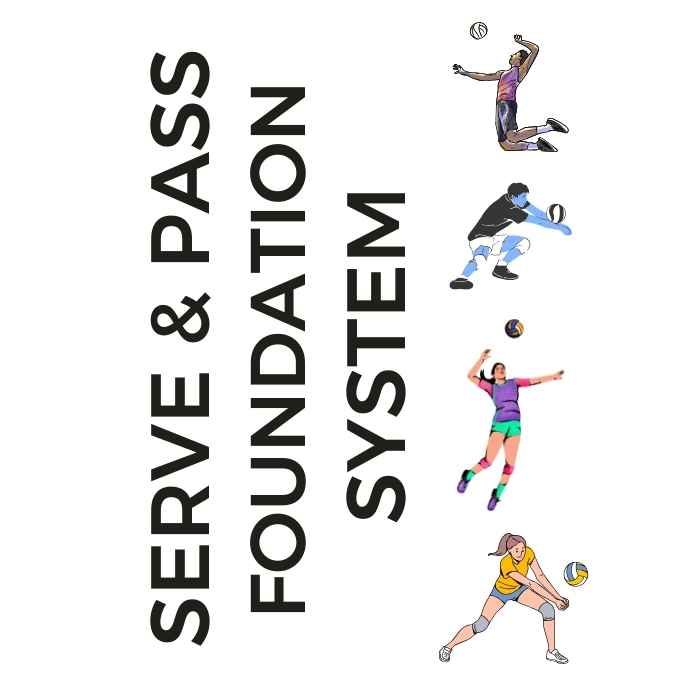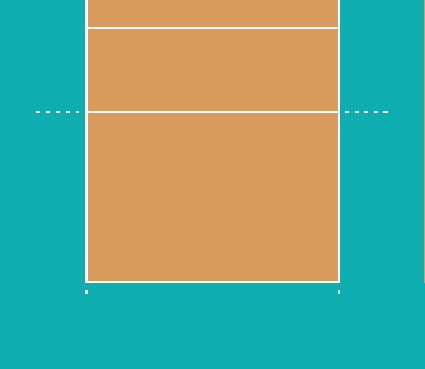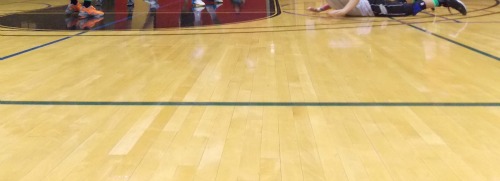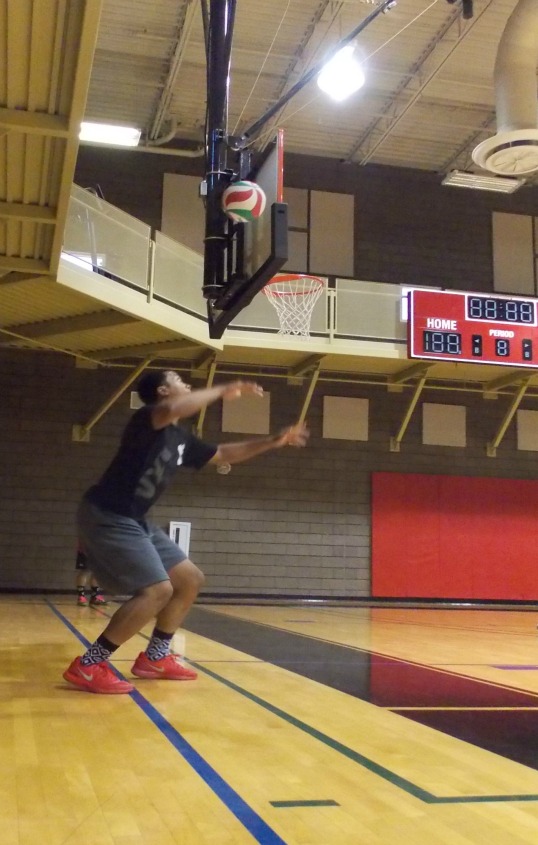
Serve + Pass Foundation System: The Complete Skills Arsenal The two-skill mastery system that transforms inconsistent players into the athletes coaches build their lineups around. Stop Struggling With The Two Most Important Skills In Volleyball!
- Improve Your Volleyball with Coach April
- Whats the Volleyball Court Size?
- The Dimensions of a Volleyball Court?
What Is the Size and the Standard Dimensions of a Volleyball Court?
Here are quick facts regarding the the size and the standard lines, nets and dimensions of a volleyball court.
 Here are quick facts regarding the the size and the standard lines, nets and dimensions of a volleyball court.
Here are quick facts regarding the the size and the standard lines, nets and dimensions of a volleyball court.In this video, Team Canada explains what the dimensions of a volleyball court should be.
The dimensions of a volleyball court are among the important aspects of being a fully knowledgeable student of the game.
Let's start by going over the official measurements of an indoor volleyball court since that's the surface we will cover in competition.
Setting up your own practice space?
These portable volleyball court boundary lines make it easy to practice anywhere.
The Indoor Volleyball Court Size
From the lines in the back of the court to the ten foot line to the net here are several quick facts about the dimensions of a volleyball court and the competitive playing surface we play this sport on.
In this video, Team Canada explains what the dimensions of a volleyball court should be.
Dimensions of an Indoor Volleyball Court
The overall measurements for a full size regulation volleyball court that includes both playing sides is 59 feet by 29 feet and 6 inches.
Diagram of the Dimensions of a Volleyball Court
What Is the Size and the Standard Dimensions of a Volleyball Court?
Here are quick facts regarding the size, standard lines, nets, and dimensions of a volleyball court.
Setting up your own practice space?
These portable volleyball court boundary lines make it easy to practice anywhere.
The Indoor Volleyball Court Size
The dimensions of a volleyball court are among the important aspects of being a fully knowledgeable student of the game. Let's start by going over the official measurements of an indoor volleyball court since that's the surface we will cover in competition.
From the lines in the back of the court to the ten-foot line to the net, here are several quick facts about the dimensions of a volleyball court and the competitive playing surface we play this sport on.
Dimensions of an Indoor Volleyball Court
The overall measurements for a full-size regulation volleyball court that includes both playing sides is 59 feet by 29 feet and 6 inches
The Height From The Ceiling
Volleyball courts should be free of any obstruction caused by any objects within a height of twenty three (23) feet above the playing space.
That's why any basketball rims or low hanging banners, posters or objects hanging over an indoor court are removed or are moved from anywhere above the playing area before the start of an official competition.
Where's The Center Line?
The center line divides the full court into two half courts and serves as a common boundary line which runs underneath the net.
It marks the center of the court and divides the playing space into two equal halves. The dimensions of a volleyball court become 9 meter by 9 meter playing halves where two teams compete against each other with a net that separates the two teams.
The diagram below illustrates the dimensions of a volleyball court with a red line where the centerline should always be located on indoor courts.
In the picture below, the center line is the blue line that divides the big playing surface into two half courts and runs underneath and parallel to the net.
In national tournaments and competitions, the extension of the attack line outside of a volleyball court should be marked with five six-inch lines that are spaced eight inches apart for a total length of 70 inches.
Basic volleyball rules use to state that players could not step across the centerline for any reason while the ball was in play.
When players, usually blockers or hitters did violate this rule, then the referee blew the whistle and awarded the ball to the opposing team for a sideout or a point and the right to serve the ball.
Where is The Attack Line?
On regulation size indoor volleyball courts, the attack line is marked 10 feet from the centerline on both sides or on both half courts.
The attack line has a couple of names, so if you hear it called the ten foot line which is what they say in the United States, or the three meter line which is what they call it in Europe and around the world, these terms all refer to the same line, the attack line.
If for some reason the the attack line (or the ten foot line) is measured at 9' 10" it should be noted that the width of the line itself which measures two inches should be included.
In the photo below, the centerline is the dark blue line visible on the left side of the photo frame.
The sideline is the dark green line closest to the bottom of the photo frame and the ten foot line is the dark green line on the right side of the picture frame where the player is laying across it.
In national tournaments and competitions, the extension of the attack line outside of a volleyball court should be marked with five six-inch lines that are spaced eight inches apart for a total length of 70 inches.
Skyrocket Your Volleyball Serving Skills with My Personalized Coaching
Ready to transform your game? My complete volleyball skills training system has helped hundreds of players master serving, passing, and more.
Where is The Service Line?
At one time the service line was restricted to an area that was marked 10 feet inside the right sideline on the end line of each opposing court.
In the picture below the service line is the dark green line that marks the end lines on both of the court halves.
In the past few years the rules were changed so that a server can serve the ball from anywhere along the endline of a regulation volleyball court.
The serve is the way to start the rally, so players can be anywhere behind the service line and inside the service zone to serve the ball, as long as they don't step on the service line when they do it.
If jump serving, or jump float serving, players still need to stay behind the line when they take off but they are allowed to land inside the court as long as they have contacted the ball before landing.
The Volleyball Net
The net is hung directly above the center line at 7 feet 4 1/8 inches for women and 7 feet 11 5/8 inches for men on a regulation size volleyball court.
The height of the net is an important factor in gameplay, influencing the trajectory of the ball during serves, attacks, and blocks. The standard net width is 39 inches (1 meter).
Where Are The Standards?
Volleyball standards should be set at 36 feet apart, 3 feet on either side of the sidelines.
What's a volleyball standard?
It's the pole system that supports the net and poles on both sides of the sidelines.
In the volleyball net diagram above the standards are those yellow poles indicated on both sides that hold the net up between them.
Dimensions of a Volleyball Court Diagram with Antennas
Antennas are used to mark the boundaries of the net and help determine whether a ball is in or out of play.
They are rigid rods measuring 3/8 inches (1 cm) in diameter and 32 inches (80 cm) in length. The antennas are attached to the outer edges of the net on opposite sides, extending vertically upward.
Following these standardized dimensions and measurements ensures fair and consistent gameplay across all levels of volleyball.
Frequently Asked Questions about the Dimensions of a Volleyball Court
Q: What are the official dimensions of a volleyball court?
A: The official dimensions of a volleyball court are 59 feet by 29 feet and 6 inches for a full court. For a half court, the dimensions are 29 feet 6 inches by 29 feet 6 inches.
Q: Are there any standard measurements for the net height?
A: Yes, the net height is set at 7 feet 4 1/8 inches for women's volleyball and 7 feet 11 5/8 inches for men's volleyball.
Q: How wide are the sidelines of a volleyball court?
A: The sidelines of a volleyball court are not specified in the official dimensions. However, they are typically around 10 feet wide.
Q: What is the width of the endline in volleyball?
A: The endline width is not explicitly defined in the official dimensions. However, it can be considered to be the standard width of 2 inches, similar to the sideline.
Q: Where is the center line located on a volleyball court?
A: The centerline runs perpendicular to the net and divides the court into two equal halves. It extends from one sideline to the other, dividing the court into two 29 feet 6 inches by 29 feet 6 inches sections.
Q: What are the dimensions of the attack line in volleyball?
A: The attack line, also known as the ten-foot line, is located 10 feet away from the centerline on both sides of the court.
Q: How deep is the service zone in volleyball?
A: The service zone extends 6 feet behind the endline on each half of the court, providing enough space for the server to serve the ball.
Q: Is there a specific measurement for the free zone in volleyball?
A: Yes, the free zone, which is the area surrounding the outside of the court, has a minimum width of 6 feet 6 inches or 2 meters.
Q: Are there any regulations for the height of the ceiling above a volleyball court?
A: Yes, the ceiling must be free of any obstructions within a height of 23 feet above the playing area to ensure unrestricted play.
Q: Can the dimensions of a volleyball court vary for different levels of play?
A: While the official dimensions remain the same across all levels, variations in court size may occur in non-regulation or recreational settings.
Remember, these are commonly asked questions about the dimensions of a volleyball court, but if you have any specific questions or need further guidance, feel free to ask!
My Volleyball Net Equipment Recommendations
Understanding volleyball net specifications is essential, but having the right net equipment is equally important.
As a professional coach, I'll guide you through selecting the appropriate net systems for different levels of play.
My SEASONAL BUYING GUIDE
Volleyball Net Systems
Spring (March-May)
Best Time to Buy:
- Indoor competition nets (end of season sales) - Outdoor system packages
Pro Tip: Look for package deals combining nets with antennae
Summer (June-August)
Best Time to Buy:
- Weather-resistant equipment
Pro Tip: Watch for mid-summer clearance sales
Summer (June-August)
Best Time to Buy:
- Weather-resistant equipment
Pro Tip: Watch for mid-summer clearance sales
Fall (September-November)
Best Time to Buy:
- Indoor competition nets (pre-season)
- Complete volleyball system upgrades
Pro Tip: Back-to-school specials often include net systems
Winter (December-February)
Best Time to Buy:
- Previous year models
- Replacement parts
- Accessory packages
Pro Tip: Holiday sales offer best prices on premium nets
PART 2: MAINTENANCE AND SETUP GUIDE
PRE-SETUP CHECKLIST:
□ Inspect all cables and hardware
□ Check for proper tools
□ Verify pole system compatibility
□ Clean setup area
□ Review height requirements
PROFESSIONAL NET SETUP:
1. Initial Setup
- Position poles correctly
- Attach bottom cable first
- Thread top cable
- Install side tapes
2. Tensioning Process
- Bottom cable first (moderate tension)
- Top cable second (full tension)
- Side tape adjustment
- Final bottom cable tightening
3. Height Adjustment
- Measure both sides
- Center height check
- Antenna alignment
- Final measurements
MAINTENANCE SCHEDULE:
Daily:
- Check tension
- Inspect for tears
- Clean visible marks
- Verify height
Weekly:
- Deep clean net
- Check all hardware
- Inspect cables
- Test tension system
Monthly:
- Complete system check
- Hardware maintenance
- Cable inspection
- Tension system service
Seasonal:
- Deep cleaning
- Hardware replacement
- Cable replacement if needed
- Complete system inspection
STORAGE GUIDELINES:
Short-Term Storage:
- Roll net properly
- Avoid sharp bends
- Store in dry area
- Keep hardware together
Long-Term Storage:
- Clean thoroughly
- Roll on tube/pole
- Use storage bag
- Climate-controlled area
- Keep documentation
TROUBLESHOOTING:
Common Issues & Solutions:
1. Loose Tension
- Check hardware
- Inspect cables
- Verify pole stability
- Adjust tension system
2. Uneven Height
- Check pole heights
- Verify floor level
- Adjust guy wires
- Measure all points
3. Net Damage
- Assess repair needs
- Use repair tape
- Document damage
- Consider replacement
4. Hardware Issues
- Inspect all parts
- Replace worn items
- Maintain spares
- Document repairs
PRO MAINTENANCE TIPS:
- Keep spare hardware
- Document maintenance
- Take setup photos
- Train multiple people
- Maintain tool kit
Volleyball Net Measuring Tools
Premium Choice: - 3M Volleyball Court Line Marking Kit
* Professional-grade adhesive tape
* 2-inch regulation width
* Non-damaging removal system
* Complete with measuring guides
* Price Range: $199-249
Mid-Range Option: - Court Marking Tape Pro Series
* 100-foot rolls
* Multiple color options
* Indoor-specific adhesive
* Installation tools included
* Price Range: $149-179
Budget-Friendly: - Sport Court Basic Line Kit
* Standard width marking tape
* Basic installation tools
* Suitable for temporary setups
* Price Range: $89-119
Dimensions of a Volleyball Court:
Where Do You Go From Here?
Where's the best place to go from here? Here are three options:
- Learn more about the Net Height.
- Follow the suggested reading on our Sitemap page Learning How To Play (Sitemap)
- Or visit the pages in the Volleyball Rules section in the drop down menu at the top of the page.
If your athlete struggles with consistent serve receive, gets subbed out, or is overlooked for playing time—this is the fix you’ve been looking for.

Struggling with passing consistency?
I help talented passers tired of getting pulled from games because of inconsistent serve receive skills BUILD passing confidence without expensive private lessons using the same 3-step system that's helped dozens of my athletes get recruited.
Download my eBook for $17.99 and start building the passing confidence that keeps you on the court—and gets you seen by college coaches.
From Lady Vol to Legend: Coach April Produces Powerful Passionate Players...is that you?
What Are You Looking For?
Click to Download Your Pre Serving Ritual Mastery Checklist pdf:
🎯Volleyball Pre Serving Ritual Guide -
Players! Learn How To Transform Your Serve from Weak to Weapon
Click to Download Your Parent's Volleyball Serving Checklist pdf
🎯Parent's Volleyball Serving Checklist Guide
Parents! Help Your Player Develop Championship Serves (Even If You've Never Played)

Hi there!
Thanks for stopping by. Hope you learned something today that will help you reach your volleyball goals.
Be sure to subscribe to my email newsletter so you can learn more each week!
Stay strong! Stay motivated!
-Coach April

SUSCRIBE to my email newsletter below!
 Click to learn more about the weekly volleyball classes and clinics or email info@imrpoveyourvolley.com for information
Click to learn more about the weekly volleyball classes and clinics or email info@imrpoveyourvolley.com for informationCongratulations to my seven Boys-18s Vegas Volley club players who played in two state championship finals yesterday, the 3A and 5A State champinship finals at Sunrise Mountain High School.
TOURNAMENT CHAMPIONS!
A-1 Vegas Volley VBC
In It To Win It Tournament
May 2 - 4, 2025 Tournament
Gold Medalists
18s Premier Division
Vegas Volleyball's Unsung Heroes: Celebrating Moms with Peace Love Volleyball Shirts
Ready to energize your volleyball mom journey?
Subscribe to my 'Producing Powerful Passionate Peaceful Players' email list above on ImproveYourVolley.com.
You'll receive energy-boosting tips, exclusive insights from me, Coach April Chapple on maintaining momentum in volleyball.
Let's power up the Vegas volleyball scene together!
Recent Articles
-
5 Essential Serving Tips from Tennessee's #2 Career Aces Record Holder
Dec 09, 25 11:39 PM
I've identified the 5 essential serving tips that separate confident servers from struggling ones and you'll serve with the confidence that creates aces -
The Volleyball Toss How Consistent Is Your Ball Toss Before You Serve?
Dec 07, 25 12:29 AM
The volleyball toss for the overhand serve needs to consistently be two feet up in the air and one foot in front of front foot which puts the ball in front of your serving arm. -
Shop Small: Real Volleyball Training With + Results From A Real Coach
Dec 03, 25 10:30 AM
Support a woman-owned business. Get training from a former elite pro with 13+ years coaching experience. Ditch the big box store--invest in proven results.
Bestselling
Volleyball Nets
on Sale!














































